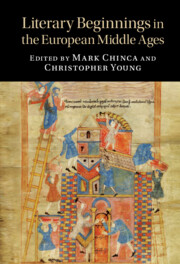Book contents
- Literary Beginnings in the European Middle Ages
- Cambridge Studies in Medieval Literature
- Literary Beginnings in the European Middle Ages
- Copyright page
- Contents
- Contributors
- Acknowledgments
- Foreword
- Chapter 1 Introduction
- Chapter 2 Scandinavia
- Chapter 3 Irish and Welsh
- Chapter 4 English
- Chapter 5 Spain
- Chapter 6 French
- Chapter 7 Dutch
- Chapter 8 Occitan
- Chapter 9 German
- Chapter 10 Italian
- Chapter 11 Czech and Croatian
- Chapter 12 Greek
- Chapter 13 East Slavonic
- Afterword
- Index
- Cambridge Studies in Medieval Literature
Chapter 9 - German
Published online by Cambridge University Press: 11 August 2022
- Literary Beginnings in the European Middle Ages
- Cambridge Studies in Medieval Literature
- Literary Beginnings in the European Middle Ages
- Copyright page
- Contents
- Contributors
- Acknowledgments
- Foreword
- Chapter 1 Introduction
- Chapter 2 Scandinavia
- Chapter 3 Irish and Welsh
- Chapter 4 English
- Chapter 5 Spain
- Chapter 6 French
- Chapter 7 Dutch
- Chapter 8 Occitan
- Chapter 9 German
- Chapter 10 Italian
- Chapter 11 Czech and Croatian
- Chapter 12 Greek
- Chapter 13 East Slavonic
- Afterword
- Index
- Cambridge Studies in Medieval Literature
Summary
This chapter surveys the formation of German vernacular literature between the ninth and thirteenth centuries. Instead of one single beginning, from which all the rest flows, we encounter a series of inaugural gestures and moments of inception, not all of which extended into posterity. The great monuments of Old High German literature, produced in the ninth century, are isolated works that did not give rise to continuous traditions of textual production; for that development, we have to wait until the second half of the eleventh century, when an astonishingly self-assured and formally sophisticated literature – now linguistically Middle High German – burst onto the scene. In the course of the twelfth century, religious genres were joined by secular ones, and the pragmatic functions of informing and instructing the public were supplemented by an interest in the potentialities of poetic language and distinctly literary modes of cognition. Finally, by the early thirteenth century, a palpable sense had emerged among collectors and authors that German literature has both a canon and a history; the constitution of manuscript anthologies and literary genealogies represents a further beginning in the formation of German literature as a dynamic system, as well as itself positing beginnings.
Keywords
- Type
- Chapter
- Information
- Literary Beginnings in the European Middle Ages , pp. 179 - 202Publisher: Cambridge University PressPrint publication year: 2022



